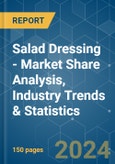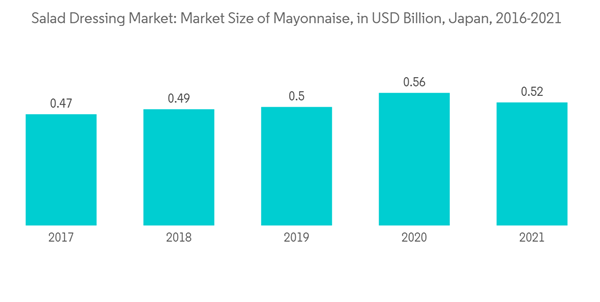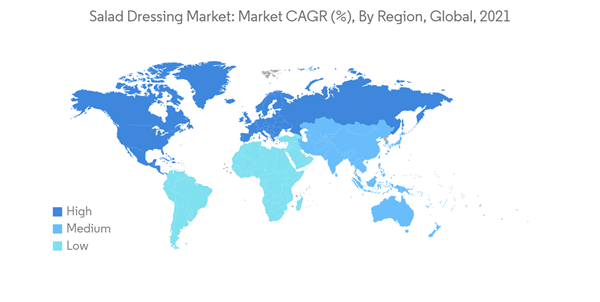The Salad Dressing Market size is estimated at USD 79.64 billion in 2024, and is expected to reach USD 103.93 billion by 2029, growing at a CAGR of 5.47% during the forecast period (2024-2029).
Consumption of food products, such as pasta and rice, with various sauces, condiments, and dressings remains in vogue globally. Increasing the shift toward consuming processed food products is expected to boost the demand for salad dressings. Consumers are more attracted to new ethnic flavor trends such as Japanese, Thai, and Chinese foods, which utilize a considerable quantity of salad dressings to serve. Factors such as convenience, affordability, and innovative food preparation are responsible for the shift from restaurants and cuisines to household consumption of salads and salad dressings.
Additionally, health claims associated with plant-based salad dressings have been gaining popularity among consumers. Moreover, salads are increasingly recommended for weight-management diets, and salad dressing plays a crucial role in enhancing salads' aesthetic appeal and palatability. Taking advantage of the opportunity, product development in this category is becoming increasingly competitive. For instance, in January 2021, Heinz introduced three different bean burger variations along with veganized salad creams and mayonnaises. The two vegan-friendly bean burgers come in original and Mexican flavors, and the egg-free mayonnaise alternatives come in original, garlic aioli, and chili flavors.
Consumers also prefer cream-based salad dressings. In contrast, mayonnaise is used by many consumers as a base for salad dressing around the globe, as consumers prefer the product as an alternative to regular ketchup. According to a survey by Ajinomoto, in 2021, the market size of mayonnaise in Japan was USD 0.52 billion. Japanese mayonnaise is commonly thicker in texture than Western products and sold in soft squeeze bottles, with Kewpie being the most recognized brand in the domestic market. Rising demand for cream-based salad dressing is also due to the variety of flavors and tastes available to consumers. Consumers are attracted to mayonnaise, one of the primary reasons driving the market.
This product will be delivered within 2 business days.
Consumption of food products, such as pasta and rice, with various sauces, condiments, and dressings remains in vogue globally. Increasing the shift toward consuming processed food products is expected to boost the demand for salad dressings. Consumers are more attracted to new ethnic flavor trends such as Japanese, Thai, and Chinese foods, which utilize a considerable quantity of salad dressings to serve. Factors such as convenience, affordability, and innovative food preparation are responsible for the shift from restaurants and cuisines to household consumption of salads and salad dressings.
Additionally, health claims associated with plant-based salad dressings have been gaining popularity among consumers. Moreover, salads are increasingly recommended for weight-management diets, and salad dressing plays a crucial role in enhancing salads' aesthetic appeal and palatability. Taking advantage of the opportunity, product development in this category is becoming increasingly competitive. For instance, in January 2021, Heinz introduced three different bean burger variations along with veganized salad creams and mayonnaises. The two vegan-friendly bean burgers come in original and Mexican flavors, and the egg-free mayonnaise alternatives come in original, garlic aioli, and chili flavors.
Salad Dressing Market Trends
Rising Demand for Cream-Based Salad Dressing
With the development of science and technology, the consumer's lifestyle is changing. Consumers are becoming more aware of health issues and several chronic diseases. Therefore, consumers mostly prefer healthy food as their first preference. Consumers eat salad dressing with salads mainly because the product provides them with better taste and nutrition. According to the USDA Foreign Agricultural Service, in 2021, the sales volume of sauces, dressings, and condiments in the Indian packaged foods market amounted to 814 thousand metric tons.Consumers also prefer cream-based salad dressings. In contrast, mayonnaise is used by many consumers as a base for salad dressing around the globe, as consumers prefer the product as an alternative to regular ketchup. According to a survey by Ajinomoto, in 2021, the market size of mayonnaise in Japan was USD 0.52 billion. Japanese mayonnaise is commonly thicker in texture than Western products and sold in soft squeeze bottles, with Kewpie being the most recognized brand in the domestic market. Rising demand for cream-based salad dressing is also due to the variety of flavors and tastes available to consumers. Consumers are attracted to mayonnaise, one of the primary reasons driving the market.
North America Holds A Prominent Share in The Market
North America has the world's largest salad dressing market. This is because of this region's salad dressing and salad consumption rate. The primary reason for shifting toward this market is the consumer's tastes and preferences towards optimizing the consumption of nutritious products, which is one major factor driving the growth of the salad dressings market in the region. For example, in the United States of America, the most preferred salad dressing flavor is ranch, followed by Caesar and vinaigrette. According to Progressive Grocer, in 2021, mayonnaise will be the top condiment in the United States. The ranch was in second place, with almost USD 103 million of ranch sold in 2021. With the rising awareness towards health and consumers preferring salad as their regular meal, consumers are eventually using salad dressing for a better taste and to gain additional health benefits, which is one of the significant reasons driving the market.Salad Dressing Industry Overview
The global salad dressing market is competitive due to the presence of a huge number of domestic and international players. Some major key players in the salad dressing market include Unilever PLC, Dr. Oetker KG, American Garden, Conagra Brands, Inc., and Hormel Foods Corporation. Emphasis is given to corporate mergers, expansions, acquisitions, and partnerships, as these strategies are used by leading companies to boost their brand presence among consumers. In addition, unique strategies by prominent players attract many consumers toward the impulsive buying of the product, thus increasing the demand for the product. Some of the top players also use product innovation as their key strategy, which empowers these companies to meet the consumer's taste by introducing new products to the market.Additional Benefits:
- The market estimate (ME) sheet in Excel format
- 3 months of analyst support
This product will be delivered within 2 business days.
Table of Contents
1 INTRODUCTION
4 MARKET DYNAMICS
5 MARKET SEGMENTATION
6 COMPETITIVE LANDSCAPE
Companies Mentioned (Partial List)
A selection of companies mentioned in this report includes, but is not limited to:
- Unilever PLC
- Dr. Oetker KG
- Conagra Brands, Inc.
- Kewpie Corporation
- Mizkan Holdings Co. Ltd.
- The Kraft Heinz Company
- Veeba Food Services Pvt Ltd
- Remia International
- Campbell Soup Company
- Hormel Foods Corporation
- American Garden
Methodology

LOADING...










